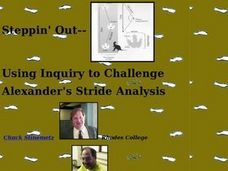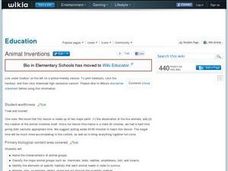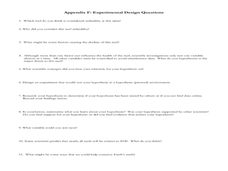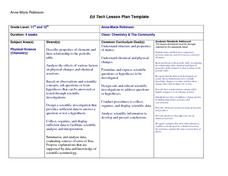Curated OER
WHAT, IF ANYTHING, IS A ZEBRA?
Students read the essay, "What, If Anything, Is a Zebra?" following a teacher made reading guide. They investigate cladistics, shared derived characteristics, with further online research to enhance their study of evolution and...
Curated OER
Feathered Feeders
Pupils investigate variation in bird beaks and the interrelationships of form and function by classifying birds with similar beak shapes, inferring about the possible bird foods based on beak shapes, and locating and identifying possible...
Curated OER
Elementary Animal Classification
Students investigate eight basic animal groups, and identify the different groups through knowledge of animal characteristics, changes, and life cycles of each group.
Curated OER
Animals and Habitats of the Chesapeake Bay
Young scholars work in small groups to discover the various habitats present in Chesapeake Bay and the animals that live in them. After investigating the habits and lives of the animals they will draw conclusions about other habitats...
Curated OER
Steppin' Out: Using Inquiry to Challente Alexander's Stride Analysis
High schoolers distinguish between walking, jogging and running trackways in humans. They analyze the phylogenetic progression of the leg position as described by pace width and angulation, comparing amphibians, reptiles and mammals....
Curated OER
Chick Embryology
Students investigate techniques that can be used to observe the development of the chick embryo. They explore the environment in which the chick develops and how it can be manipulated.
Curated OER
Look Up - Birds
Students investigate the concept of birds. They identify five different types of birds and name the characteristics that make them different than other living things. Students also name the different parts of the bird and how they are...
Curated OER
Animal Inventions
Students name the characteristics of animal groups. Students classify the major animal groups such as: mammals, birds, reptiles, amphibians, fish, and insects. They identify the elements of specific habitats that each animal needs in...
Curated OER
Sorting
Students identify how objects can be sorted or classified for easy access. In this sorting activity, students will investigate how letters, numbers, and symbols are used in sorting and classifying.
Curated OER
Life at Risk
Students examine the characteristics of the peregrine falcon. They investigate endangered and extinct species, and how the environment affects the process.
Curated OER
Coqui Frog Camouflage
Students investigate the concept of the coqui frog of Puerto Rico. They conduct research using a variety of resources. Students explain in oral or written form some of the characteristics to that identify the frog. The lesson includes...
Curated OER
Animal Classifications
Third graders work in small groups to investigate how to sort a variety of items into groups and subgroups. They work on a class chart based on the activity which show how the items are classified based on commonalities. Upon completion...
Curated OER
Evolution: Natural Selection
Learners analyze and discuss the evolutionary history of dinosaurs. In this investigative lesson students monitor different organisms in the environment and analyze the pressures that affect the chances of survival.
Curated OER
Native Versus Exotic
Students investigate the presence of exotic and natural species in the ecosystem. They define the differences between exotic and native while looking at one specific ecosystem in Maryland. They write how the exotic species are considered...
Curated OER
Cool Corals
Students research questions pertaining to ecology and biology of shallow and deep water corals. In this investigative activity student get into groups and design questions that will expand their knowledge of corals.
Curated OER
Mayflies on the Move!
Seventh graders investigate mayflies and their environment. In this biology instructional activity students examine the relationship between the mayfly and the water quality of Lake Erie.
Curated OER
Marshland Ecosystem
Students classify animals based on their physical characteristics and eating habits. In this animal identification lesson plan, students investigate the life forms shown on a Parisian ceramic basin, and discover ecosystem the artist was...
Curated OER
Invent a Plant
Students investigate plant adaptations. In this plant adaptations lesson, students create a model of a plant. Students are given action cards detailing specific environmental situations. Students design their plant to adapt to the...
Curated OER
Animal Groups
This animal science PowerPoint allows students to investigate types of animal groups. The slides contain clear information about herbivores and carnivores and explains their diet. This is a great way to introduce animal groups to students.
Curated OER
Avalanche!
Pupils explain that when forces on an object are balanced, the motion of object does not change. They describe how an object changes its motion when forces on it are unbalanced. They plan and conduct a scientific investigation to test a...
Curated OER
Marine Biology Lesson on Understanding the Dynamics of the Reef Ecosystem
Students compare data from a healty and unhealthy reef ecosystem. In this marine biology lesson, students identify which sample is stressed. They formulate a hypothesis on why the reef is stressed and support their hypothesis with proven...
Curated OER
Yellow Pod
Students use appropriate skills to design and conduct scientific investigation. They sort and classify various ingredients and analyze their investigation. Finally, students describe the observable states of matter, bot solids and liquids.
Curated OER
Scientific Inquiry
Middle schoolers make inferences about what activities occur at different places in school. They form a hypothesis as to how space is used. They simulate how archeaologists explore past people by designing and conducting a research project.
Curated OER
Chemistry & The Community
Students complete a Webquest which investigates the chemistry in items such as shampoo. They research the Internet, perform a lab experiment, and write a scientific lab report with their findings. Upon completion of the activities, the...

























